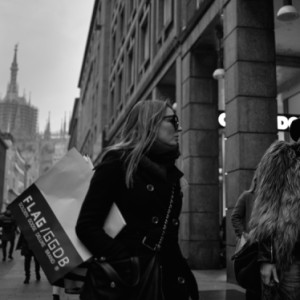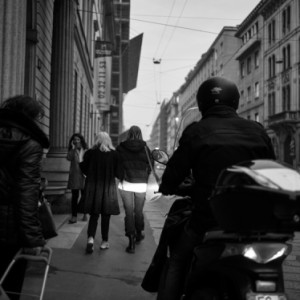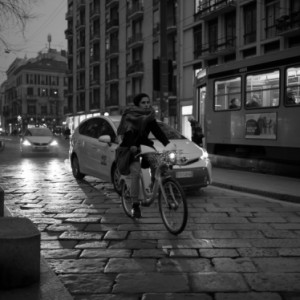MonoMonday Challenge - 158 At Hip Level
Thanks again to Marlieske for hosting an interesting MonoMonday month and especially for her last theme this month, which I feel most at home. At some point I need to update my Blip biography as my photographic journey develops and this entry may be the catalyst.
At hip level, from the hip, robbing shots, gimping, stalking… whatever you may what to call it, it is the street style I have adopted for a long time now. I like many different kinds of photography and my Blip journal has helped me explore these along the course of the last 4+ years with a certain regularity. Family, portrait, detail, landscape, travel, reportage, one street, automotive when I find the opportunity… and street. In my walk along Blip, street has been the one constant in that I take my camera with me everywhere. Living in a large city helps this immensely. With the difficulty of managing work and family, photography has been the single easiest hobby to keep alive (not so easy to manage and curate, but easy to take the camera and string it on your neck). Many are the night my wife asks me, “What are you typing away at the computer?” (For the love of being married, I have since let go of the need to document most of my Blips or to feel accountable to make the post on the same day of the photo – hence many many back-Blips). My 7 y.o. daughter also now nags at me if I turn the computer on at home… ah…. What to do. I have many projects I would like to complete, but no chance to dedicate any real time to the effort. So… it is easy to just keep snapping pictures. Someday I will make sense of it all!
I wish Marlieske would have found a different inspiration than Erik Kim for today’s theme, but that is probably a personal opinion of mine. He is young and jumped into photography with a lot of enthusiasm, but unfortunately, I don’t like his attitude and language often times.
What does it mean to me? Street photography is a wonderful mix of spontaneity, intuition, chance, speed and skill. I purposely left out interpersonal skills since it is not a major factor in my approach. I want to be as invisible as I can to capture a moment that doesn’t have the weight of an individual feeling that a person is being observed or that they have to perform for the camera. I want something that is honest and a slice of life that is happening around me as I pass by on my way. There was a phrase in a Dennis Hopper photography book that has marked me deeply, quoting loosely of Robert Doisneau, (and me quoting even more loosely) that a photographer has the ability to look at a situation and point his finger at it and say, “that is art”, click, – and it is.
Early on in Blip, there were a few acquaintances that helped me immensely in my creative persuit. The first was Tomasz who said two things… a picture doesn’t have to always have the object centered in the frame, and enlightened me on the rule of thirds – to use at discretion. Then there was a Henry Cartier-Bresson discussion on the idea of the first 10,000 shots [during the age of film] and the idea of the defining moment. Somebody somewhere along the way said that you have no more than 3 seconds to get the shot. I now think that the defining moment is something continually in flux and the time you have is actually considerably less! Thanks also to SteinJ for his idea to keep a photo record to break sometimes the routine of life and to offer an outlet for humor in our daily lives. Thanks also to Dmarc for being able to strive for personal perfection and to show what impact a clean esthetic can give to a photo. I wish I had more time to spend with each of these people and surely many more.
Living in Milan, I have had the great fortune to meet many renown photographers of different backgrounds – each with a different approach and story to tell. One of the early challenges was never shoot a picture of someone in unfortunate circumstances or any photo where later the person may challenge that the photo was unflattering or worse (I have never stopped to ask for a model release!) For better or worse, I largely avoid taking pictures of children – if not my own or of friends with their consent. These are the times. Kids are the best! They are so funny, honest and spontaneous. Funny memory that my mother a few years ago had mentioned negatively how I had taken pictures of the children in the bath that I sent via email. Funny that I found pictures in a box afterwards by her mother of us kids visiting sleeping nearly nude on the beds and sofa. Haha. (Not being Polaroids, obviously haven been developed in a photo lab.) Puritan, ok. But, life is life. The pictures are beautiful and paint a moment in life that was very sincere to me looking back as an adult. Somethings are better not to get hung up upon least they leave negative ghosts that burden us for life. My mother is quite old now and so I think was a flash wanting to protect her grandchildren from, what she sees as, a hostile modern world. I am sure there will be somebody reading this as statistics will imply that has had the opposite experience in life and I pray both peace and vengeance in due measure. Long way around to say that I try to keep a strict ethic about the pictures I take that someone will never want to imply wrongdoing on my part.
I still take more pictures of women than men in my street photography. Fault me as you will! :) I don’t. I am also often selective (not always) of who I take a picture (not always). That is what it is and where I live. There are many other similar places in the world with a rich visual environment – New York, Miami, Paris, London, Tokyo… and so on. Milan is one of those. Ps, I also follow many photographers who portray rural or small towns – which I enjoy immensely. Milan is just one reality which I am happy to share.
I am a rangefinder shooter. I have Tomasz to thank for this barnacle in life I bear. I was set on buying a full frame DSLR camera with a couple fancy zoom lenses when I didn’t really know how to shoot the camera I already had. Somehow I thought bigger was better. Tomasz talked sense in the importance of shooting a single focal length to understand composition. Zoom is something of a cheat to get you closer or further away from your subject. Then to simplify the shooting experience with no frills – just the basic adjustments: aperture, shutter speed, iso – and of course, focus. That is me now for the last four years with a few small exceptions.
I’ve spent the last four years now following this mantra: manual is faster than autofocus. I’ve learned the muscle memory for different lenses – where my hand and fingers rest on the camera and how much of a turn is 1-2-3-5-10 meters distance on my favorite lenses. I know how to pace the distances as I walk and as someone approaches me.
So here at last is my vision for street photography:
Never stop. Never, never stop. Keep walking. You never know what you are going to miss out in front of you if you stop.
Only stop when the situation warrants or allows a photographer to enter the circle without disturbing the dynamic (tango dancers in the gallery at night? Yes! Definitely!!)
It’s ok to slow down or to speed up your pace if you see a situation that is going to happen.
Never back track. Exception is rule 3 if you see a situation that is going to happen.
When in doubt, take a picture. Intuition and mojo don’t always talk together. Sometimes brute force is required to make them get along.
Don’t waste your film (or battery life). i.e. life isn’t a Hollywood film. No need to machine gun the memory card.
Never never never never use auto review. Turn it off!!! It ruins your flow. It gives you away. It creates doubt. I robs yourself of self-esteem (good picture/bad picture?) Trust yourself. Do your editing at home.
Check your pictures only when in doubt of lighting to adjust basic camera settings like ISO, shutter speed. (You can actually do this through the viewfinder as you take a picture, if you use the viewfinder – or just leave everything in automatic. Nah.)
No comment on light metering. I use center spot metering. It works for me (not always). It works for me (because I know no better).
Use your camera in full/semi-manual. I typically will only leave the shutter speed in auto when I am zone focusing unless I know the light very well. If I am hyperfocusing, then I will usually leave it in full manual.
-- Hyperfocus – stopping down the lens aperture to a minimum amount and focusing to a ‘mid’ distance that will guarantee to have an acceptable focus precision across the photo.
-- Zone focus – leaving the lens aperture as wide open as possible (per minimum ISO or maximum shutter speed allowed on your camera in bright light) to create a very shallow depth of view. Typically the shorter the focus distance the more shallow depth of view. If focusing to infinity with a wide-open aperture, you may be hard pressed to notice anything out of foucs depending if there are objects in the nearground.
-- Idea of bokeh (soft, out of focus) is related to zone focusing. It’s possible to have both near and far bokeh depending on the element in the composition and the chosen focal length.
My idea of the world starts from down low – away from eye-to-eye contact. This functions in two ways: it keeps the perspective as a younger person looking up into the world, it avoids drawing the attention to the camera. I will usually draw eye contact while the camera remains a third person to the situation. Often times a person’s gaze will naturally drift to the camera (I have my hand on it and it is an important accessory). I like taking the picture at that moment – very neutral and transparent.
My idea of the world includes bokeh. Like the eye and the limits of human perception, we are typically ranging with our eyes when we observe any given moment. Though our peripheral vision is very large, we typically are concentrating on one or two subjects and not the all. I like this approach to photography. I like to look into a portion of an image where it is clear the intent.
I like hyperfocal technique from time to time. Why not. Life is a box of chocolates. Always something new to explore. Why just do one thing? Sometimes it can be intoxicating to read a photograph in detail from the front to the back and to the front again.
I am framing my pictures by: intuition, muscle memory, knowing the lens field of view, understanding the focal length, timing, more intuition, and lastly – luck, a lot of luck.
Cropping is OK. Your keeper rate will go up with practice, mojo and skill. I am absolutely horrible to keep the camera straight. I have read many predominant photographers say that cropping is dishonest and that the photographer should make all adjustments in the camera. That is rubbish when talking about street!!! Some may like the artistic look of a tilted photo, but to be honest it gets old and tires the eye, unless used very sparingly in an overall collection of photographs. A photo is most enjoyable when the eye perceives that it is straight with the world.
Cropping is OK. Again, shooting from the waist, or in my vision walking to make a picture, it is impossible to make all the elements work in a picture all of the time. I have made a quick read recently of a book on composition by Larry Fink, which impressed me. A good photograph should have tension and elements that build depth into the image. Cropping can help.
Cropping is OK. I had the rare fortune to attend a masterclass with Joel Meyerowitz who shoots most of his street with a hyperfocal length to get the entire image in focus and to be able to read all the detail close and far. Joel walks a lot too, but he will stand his ground to get a photo he wants, but also quick to catch the situations as they happen. I don’t think he crops much, but then he is Joel Meyerowitz. Anyway, my point is to catch the situation and not lose it at the risk of taking time to create the composition.
A bad photo is just practice. Learn to curate your work and delete the bad pictures. Sometimes no amount of cropping or straightening can make a picture good. Sometimes the light is just bad. Sometimes your focus is off. Sometimes you don’t match the shutter speed to the situation. I still tend to keep too much trash on the hard disc, but I am getting better.
Don’t publish to social media on the same day as the photo. Except for Blipfoto of course! Blip is great to create a discipline to look for the most eye-catching or the story you want to tell. Otherwise, I tend not to publish anything on the same day I shoot the picture. First is a time factor to manage the pictures/family/etc, second is an emotional value. I tend to place a higher initial value of a picture’s worth much than what it deems. I have to look many times and then often across several days before I can judge a pictures content. I may still be producing trash (who is to say), but I will usually wait 3-4 months before posting pictures to Flickr or 500pix. I don’t earn any money from my pictures and so is just a hobby for me, but I am still trying to approach from a high level.
Learn to curate and edit your work. I will post a bit of everything on Blipfoto, but I still try for some sort of consistency. I am much harder on myself on Flickr where I try to stick to just a few themes. I will also for the most part limit myself to posting only a few pictures per day and to footnote the pictures adequately. I hope we can begin to offer again on Blipfoto the opportunity to print books of our yearly journal, which I found immensely satisfying from the first year – both as a time stamp on the year and also as a progression.
Stick to your guns. If you’ve got this far, I’ve just described my vision of street photography and a bit more! Yours will surely be different. In the name of art or hobby (passionate amateur), you should be willing to work through a thing to its logical end. Hoping that the end of a thought or expression is not really an end (unless the passion dies), but that it takes you into a deeper understanding or a different direction to continue the journey.
If you got this far, I hope you found it interesting and I appreciate any comments and feedback you are willing to share. :)
Extras included today. :::)))




Comments
Sign in or get an account to comment.


